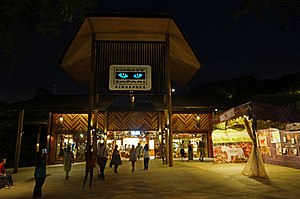Night Safari, Singapore
This article possibly contains original research. (July 2014) |
 | |
 | |
| Date opened | 26 May 1994 |
|---|---|
| Location | Mandai, Singapore 80 Mandai Lake Road, Singapore 729826 |
| Coordinates | 1°24′08″N 103°47′16″E / 1.402260°N 103.787886°ECoordinates: 1°24′08″N 103°47′16″E / 1.402260°N 103.787886°E |
| Land area | 35 ha (86 acres)[1] |
| No. of animals | 900[1] |
| No. of species | 100[1] |
| Annual visitors | 1,321,718 (FY 2019/20)[2] |
| Major exhibits | 59 |
| Public transit access | |
| Website | Night Safari |
The Night Safari is the world's first nocturnal zoo and is one of the most popular tourist attractions in Singapore.
The concept of a nocturnal park in Singapore was suggested in the 1980s by the former executive chairman of the Singapore Zoo, Dr Ong Swee Law. Constructed at a cost of S$63 million, the Night Safari was officially opened on 26 May 1994 and occupies 35 hectares (86 acres) of secondary rainforest adjacent to the Singapore Zoo and Upper Seletar Reservoir.
The Night Safari currently houses over 900 animals representing over 100 species, of which 41% are threatened species.[1] The Night Safari is managed by Mandai Wildlife Reserve, and about 1.3 million visitors visit the safari per year.[3][2] The Night Safari received its 11 millionth visitor on 29 May 2007.
Highlights[]

Unlike traditional nocturnal houses, which reverse the day-night cycle of animals so they will be active by day, the Night Safari is an entire open-air zoo set in a humid tropical forest that is only open at night. It is divided into seven geographical zones, which can be explored either on foot via four walking trails, or by tram.
The animals of the Night Safari, ranging from chital deer and gaur to Indian rhinoceros and pangolins to lions and Asian elephants, are made visible by lighting that resembles moonlight. Although it is brighter than full moonlight by a few orders of magnitude, it is dim enough not to disturb nocturnal and crepuscular animals' behaviour. London based lighting designer created the lighting for Night Safari.
The naturalistic enclosures simulate the animals' native habitat. Animals are separated from visitors with natural barriers, rather than caged, similar to the Singapore Zoo's open concept. Instead of vertical prison-like cages, cattle grids were laid all over the park to prevent hoofed animals from moving one habitat to another. These are grille-like metal sheets with gaps wide enough for animals' legs to go through. Moats were designed to look like streams and rivers to enable fishing cats and servals to be put on show in open areas, and hot wires were designed to look like twigs to keep animals away from the boundaries of their enclosures.
Cultural performances are a regular feature at the safari, and include tribal dances, blowpipe demonstrations and fire eating displays.
Thumbuakar Performance
This show is performed by trained actors acting as tribe members of Africa. The actors amaze viewers by dancing and "eating" fire. By drinking a certain hydrogenised formula, they can put on a magnificent fire-blowing act.
Creatures of the Night Show
This show is a performance presented by the animals in the Night Safari. Civets show of their excellent sense of smell, a spotted hyena displays its powerful jaws, otters spread awareness to recycle reusable items and many more animals.
Food and beverage outlets in the Night Safari include Ulu Ulu Safari Restaurant, Bongo Burgers, and Casa Italia. Visitors can dine in the "Evening in the Wild" at Night Safari's only Tepee Tent. Also experience dining on the move with the Cocktail Safari Express and Gourmet Safari Express.
Awards[]
- ASEAN Tourism Association – Aseanta Awards For Excellence (1995)[3]
- Best New Attraction in ASEAN
- Singapore Tourism Awards[4]
- Top 10 Best Family Experience (2006)
- Best Leisure Attraction Experience (2003, 2004, 2006)
- Leisure Attraction of the Year (1996, 1997, 1999, 2000)
- Best Trail Marshall of the Year, Mohammed Munzir Aziz. (2008)
- Best Trail Marshall of the Year, Mohammad Ridhwan Shahril. (2009)
- Best Ground crew of the Year, Vijayeswaran Visvalingam. (2009)
- Best Animal Caretaker of the Year, Hadi Akmal (2015)
Transportation[]
Night Safari is not served directly by any MRT line, with the nearest station being Springleaf MRT station which opened on 28 August 2021.
There are three bus services operated by SBS Transit and SMRT Buses which calls at the bus stop near to the Zoo.[5]
Bus[]
A shuttle service, known as the Mandai Khatib Shuttle, plies daily between Khatib MRT station and the Zoo. A one-way trip cost $1 for everyone above the age of three.[6]
References[]
- ^ a b c d "About Night Safari". wrs.com.sg.
- ^ a b "WRS Yearbook 2018/2019" (PDF). Wildlife Reserves Singapore.
- ^ a b "About Night Safari". wrs.com.sg.
- ^ Welcome to Singapore Tourism Awards 2008
- ^ "Getting here". wrs.com.sg.
- ^ Chew, Hui Min (9 March 2017). "New daily express bus from Khatib to Mandai wildlife parks". The Straits Times. Retrieved 9 March 2017.
- Lin Xinyi, "Night Safari: From trailblazer to tourism icon", The Straits Times, 31 May 2007
External links[]
| Wikimedia Commons has media related to Night Safari, Singapore. |
- Safari parks
- Tourist attractions in Singapore
- Zoos in Singapore
- 1994 establishments in Singapore
- Zoos established in 1994

